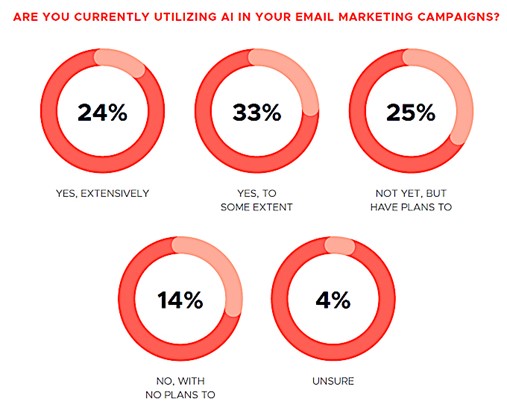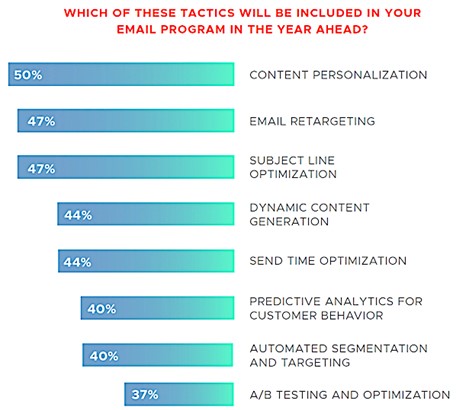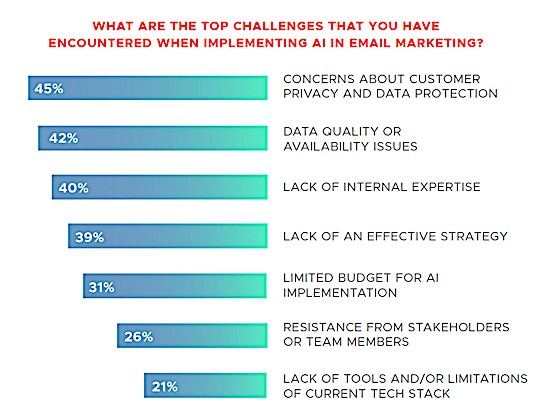How do you compare with your fellow email marketers on using AI?
Artificial intelligence, or AI, has been a regular feature here on Only Influencers, from conversations on the email lists and in our regular Thursday members-only calls to blog posts like this one.
People like Chad S. White of Oracle Marketing Consulting, Dr. Matthew Dunn of Campaign Genius, and countless others have shared their wisdom on whether and how AI will affect email marketing and the implications.
But until now, we haven't talked to email marketers themselves in a tangible way about what they think of AI and how – and whether – they're using it. We have talked about this within OI but not with marketers en masse.
That's why my agency, RPE Origin, partnered with Ascend2 on a study to talk with marketers at enterprise companies to find out what teams are doing and what their companies are thinking about and planning for generative AI.
Our report, 2023 Email Marketing & Research Report: A Look at the Market for the Future of the Channel , uncovered some surprising uses and attitudes about AI from marketers who range in experience from extensive users to those who aren't interested in AI now or ever.
What we discovered in our research can draw a roadmap for implementation when the noise of possibility is all around us.
How marketers use AI and what they want from vendors
We're pleased to bring you this research for your comments, education and guidance in forming or advancing an AI plan. If you want to cut to the chase, you can download your free copy here https://www.rpeorigin.com/2023-ai-in-email-marketing-research-report/.
Below, I'll highlight some of the most interesting findings and what they mean for marketers, for AI, and for what AI could do for the industry. These findings represent the view of marketers who say they are successful or somewhat successful at email marketing.
3 key findings about email marketers and AI
1. How marketers are using AI in email now
More than half of email marketers are using AI extensively or to some extent now, while only 14% do not and don’t plan to try it.

Source: 2023 Email Marketing & Research Report:
A Look at the Market for the Future of the Channel by RPE Origin and Ascend2
My analysis: AI in all of its forms will stick around. Those who have no plans to use AI or aren’t sure, like the combined 18% of respondents on this question, need to focus on the future and consider the possibilities that widespread AI could bring to their email programs.
Across the board, AI will affect you, either directly in the work you do or indirectly if your competitors succeed with it and you don’t.
We need to start learning about it, developing a strategic plan for it, and playing with it to discover what it could do for us.
If any of my fellow OI members are in that 24% who are using it extensively, great! Now spread the word, here on the OI blog and your own company resources, in our Thursday calls, at the Email Innovations Summit and other industry conferences. Help your colleagues and the email industry chart a path.
2. Personalization and retargeting rule for AI right now.
Content personalization is the No. 1 use for AI among all users (50%), followed by email retargeting (47%) and subject line optimization (also 47%).

Source: 2023 Email Marketing & Research Report:
A Look at the Market for the Future of the Channel by RPE Origin and Ascend2
My analysis: Content personalization, email retargeting, and subject line optimization are the top three uses for marketers who are the most experienced with AI. These three uses bring us closer to the holy grail of email marketing: relevancy on top of speed to market.
When using AI with these tactics, we can build an email message for an individual or a cohort, have a list of products or a group of content modules, and have a machine choose what to send and whom to target.
This has been possible to achieve by using top-tier programs with price tags to match. AI can accelerate the typical marketer’s ability to learn and implement the technology, thus democratizing the process at a much lower cost.
When we dug down into the numbers, we found a divide between heavy users and dabblers:
- Extensive users seek objective-based outcomes for AI, including content personalization, dynamic content generation, and advanced segmentation.
- Occasional users focus on process-related tactics like subject line optimization and send time optimization and are less likely to use AI for dynamic content and automated segmentation.
3. Marketer challenges to adopting AI include privacy, data quality, and lack of resources.
The age-old challenges of email marketing – not enough time, money, and resources – still hold true. Add a lack of expertise to the list along with fresh concerns about having enough data and protecting people’s privacy, and it’s easy to see why AI hasn’t taken over the email world yet.

Source: 2023 Email Marketing & Research Report:
A Look at the Market for the Future of the Channel by RPE Origin and Ascend2
My analysis: The tech industry hasn’t had enough time to move into adding AI tools, but they need to. What can we as tech consumers do to drive that? These steps can help:
- Tell your vendors what you need and ask them how they plan to meet those needs. The answers will tell you whether you’re working with a tech partner who can help you grow your skills and improve your email program. If the answer is light on details, it might be time to go shopping for a partner who can help you.
- Look around the tech marketplace to see what’s available. Our agency does many RFPs and platform migrations. We’ve learned over the years that companies switch tech platforms mainly because the tech no longer meets their marketing visions or needs.
Switching isn’t always the answer. Could you do better with different technology? Or could you do better with the tech you're already paying for? Getting outside training or bringing in someone with the expertise you need could help you use more of the technology you pay for right now.
If you are like the 39% who feel stymied by the lack of an effective AI strategy, it might be time to find external voices to help you put one together. An agency with experience in planning and working with AI strategy gives you an advantage because it has perspectives it has gained from working across industry verticals and a wide range of clients instead of a narrow field of vision.
Wrapping up and next steps
As I was writing my analysis of the findings in the 2023 Email Marketing & Research Report: A Look at the Market for the Future of the Channel , I marveled at one surprising finding: Marketers are feeling more confident about their technology sophistication than they did seven or eight years ago.
As someone who works with marketers, engages them here on OI and elsewhere and speaks and writes regularly on email and email marketing, this new confidence is encouraging to see. At the same time, I hope marketers don't feel overwhelmed or inadequate as we look at expanding the use of AI across the board.
The study highlights that marketers continue to struggle with a lack of resources, time, and money. Asking them to fit one more task into the daily mix is a lot, and it will take time. But AI provides an excellent use case for incremental innovation – the idea that we don't have to improve by a single great stride. Rather, we can take small steps forward and build on those improvements that add up to a big leap forward.
Naturally, we'll always have enterprise-level companies that have the time, money, and human and technological resources that can design and test big programs. But that's how we've always advanced email. Big companies toyed with programs at scale and then led the way for the rest of us.
This technology and its iterations will bring us a rebirth of conversation around what's new both inside and outside of email. It harkens back to the early 2000s when we were all learning and talking about what email meant, along with consumer adoption of the channel. It also emphasizes the dominance of email over the last 25 years.
Moving the channel in a new direction can give us advantages in products, copy, targeting and relevance and generate abundant ideas and paths forward.
We're still in the nascent stage of AI and its implications. But in one small way, we can push the boundaries. A lot is packed into the infrastructure of what we need to make these enhancements work. But let's not abandon all hope because we don't have the tools yet. Let's try things with the tools we have.
As for now, read the report (download an ungated copy) and let me know what you think. Use what you learn to create your roadmap for 2024 and beyond.
How will you change your program and your perspective? How will you educate your team and yourself about the possibilities? How will you implement this next generation of email marketing?
 Photo by Steve Johnson on Unsplash
Photo by Steve Johnson on Unsplash

 How to resolve AdBlock issue?
How to resolve AdBlock issue? 
 Ryan Phelan is Managing Director of RPEOrigin.
Ryan Phelan is Managing Director of RPEOrigin.